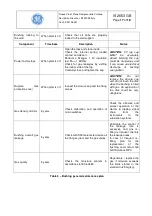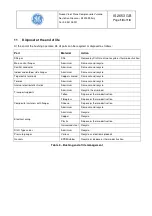
Nuova Via di Piano Comprensorio Vulcano
Sesto San Giovanni, MI 20099 Italy
Tel. 02-24105.001
IS 2653 GB
Page
4
of
18
Main safety risks related to the bushing handling and its operative conditions are:
•
Transport and handling of heavy and large parts.
•
Lifting and moving of heavy and not well balanced components.
•
Work operations under the crane and suspended materials.
•
Work at height. All operation at height
must be performed on a suitable certified platform.
•
Risk of falling down of heavy parts during the installation.
•
Risks deriving from un-proper balancing of the masses that can cause un-expected rotation during the
installation on the wall.
•
Risks due to the use of un-proper tools or wrong operations.
•
Risks deriving from un-proper installation or operation on the bushing when filled by SF6 gas at rated
filling pressure (explosion).
•
Environmental risks related to dispersion of SF6 gas in the atmosphere.
•
Severe electrical shock risk related to the extremely high voltage AC/DC level of the equipment.
•
Severe electrical shock risk due to un-proper realization of the bushing grounding connections.
•
Severe electrical shock risks deriving by the fact that the composite insulator and the other main parts of
the bushing could remain electrically charged at high voltage for a long period of time after the plant de-
energizing and the bushing grounding. Before starting any work on the de-energized bushing, check the
discharge by touching all surface of both indoor and outdoor side composite insulators and all other
parts of the bushing with an insulated grounding rod which length must be
≥
3m. Operators must wear
protective insulating gloves and boots and helmet with protective transparent face shield.
2.1
Preliminary operative information
The following notes are mandatory for personnel involved in wall bushing assembly. All problems detected
during the bushing installation must be reported to the Foreman and to GE Grid Solutions RPV Supervisor.
•
The bushing is a pressurized device. Operations on the valves, pressure gauges, pipes, protective
devices must be performed by qualified operators, with the proper equipment and respecting the
instructions of this manual. Foreman and operators have to take careful for handling the pressurized
equipment.
•
It is mandatory to use clean safety gloves and protective clothes, helmets and safety shoes during all
bushing moving, assembly, hauling and installation operations.
•
Work in quote will be done by trained operators on adequate and certified moving platforms. Workers
that will operate in quote must use the above prescribed safety devices and in addition they must wear
certified safety harnesses.
•
Lifting equipment must be adequate and certified.
•
Tools and pieces of clothes or no-fibre fabric used during the installation must be clean.
•
The composite insulators sheds are made by silicone that can be mechanically damaged if not properly
handled. Protect the insulators with clean plastic foils during the bushing installation and report to
Foreman and to GE Grid Solutions RPV Supervisor any event which could have caused a damage of
the composite insulators.
CAUTION:
It is strictly forbidden to move, lift and install any equipment that is under pressure. Check through
appropriate gauge that the devices are at a pressure less than or equal 0.15 MPa abs (0.5 bar gauge) before
operate on them.
CAUTION:
The bushing is equipped with a safety rupture disk. This is installed on the central flange and
protected by a metallic cap. Do not remove this protective cap and its relevant mechanical parts. Never touch
the safety disk with the bushing filled with gas, as it can break, causing a violent gas explosion. Maintenance
operation on the safety disk is allowed to trained operators and only after removing all gas pressure.




































